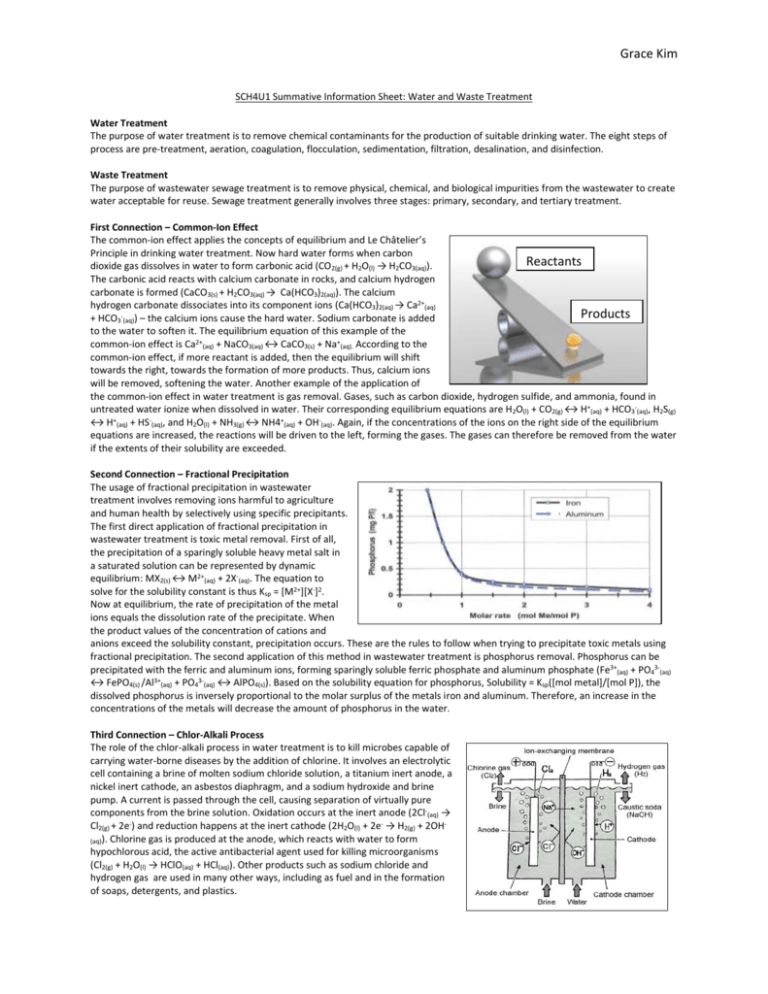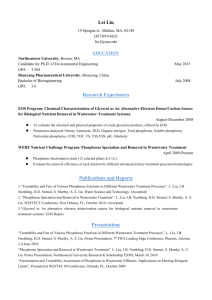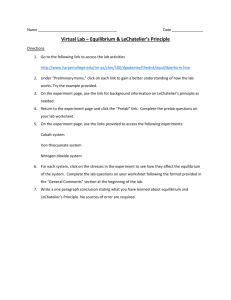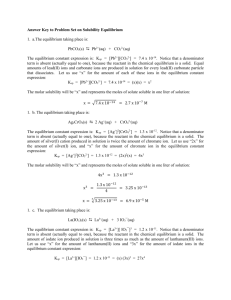Water and Waste Treatment - Grace Kim - SCH4U1-05-2010
advertisement

Grace Kim SCH4U1 Summative Information Sheet: Water and Waste Treatment Water Treatment The purpose of water treatment is to remove chemical contaminants for the production of suitable drinking water. The eight steps of process are pre-treatment, aeration, coagulation, flocculation, sedimentation, filtration, desalination, and disinfection. Waste Treatment The purpose of wastewater sewage treatment is to remove physical, chemical, and biological impurities from the wastewater to create water acceptable for reuse. Sewage treatment generally involves three stages: primary, secondary, and tertiary treatment. First Connection – Common-Ion Effect The common-ion effect applies the concepts of equilibrium and Le Châtelier’s Principle in drinking water treatment. Now hard water forms when carbon Reactants dioxide gas dissolves in water to form carbonic acid (CO2(g) + H2O(l) → H2CO3(aq)). The carbonic acid reacts with calcium carbonate in rocks, and calcium hydrogen carbonate is formed (CaCO3(s) + H2CO3(aq) → Ca(HCO3)2(aq)). The calcium hydrogen carbonate dissociates into its component ions (Ca(HCO3)2(aq) → Ca2+(aq) Products + HCO3-(aq)) – the calcium ions cause the hard water. Sodium carbonate is added to the water to soften it. The equilibrium equation of this example of the common-ion effect is Ca2+(aq) + NaCO3(aq) ↔ CaCO3(s) + Na+(aq). According to the common-ion effect, if more reactant is added, then the equilibrium will shift towards the right, towards the formation of more products. Thus, calcium ions will be removed, softening the water. Another example of the application of the common-ion effect in water treatment is gas removal. Gases, such as carbon dioxide, hydrogen sulfide, and ammonia, found in untreated water ionize when dissolved in water. Their corresponding equilibrium equations are H2O(l) + CO2(g) ↔ H+(aq) + HCO3-(aq), H2S(g) ↔ H+(aq) + HS-(aq), and H2O(l) + NH3(g) ↔ NH4+(aq) + OH-(aq). Again, if the concentrations of the ions on the right side of the equilibrium equations are increased, the reactions will be driven to the left, forming the gases. The gases can therefore be removed from the water if the extents of their solubility are exceeded. Second Connection – Fractional Precipitation The usage of fractional precipitation in wastewater treatment involves removing ions harmful to agriculture and human health by selectively using specific precipitants. The first direct application of fractional precipitation in wastewater treatment is toxic metal removal. First of all, the precipitation of a sparingly soluble heavy metal salt in a saturated solution can be represented by dynamic equilibrium: MX2(s) ↔ M2+(aq) + 2X-(aq). The equation to solve for the solubility constant is thus Ksp = [M2+][X-]2. Now at equilibrium, the rate of precipitation of the metal ions equals the dissolution rate of the precipitate. When the product values of the concentration of cations and anions exceed the solubility constant, precipitation occurs. These are the rules to follow when trying to precipitate toxic metals using fractional precipitation. The second application of this method in wastewater treatment is phosphorus removal. Phosphorus can be precipitated with the ferric and aluminum ions, forming sparingly soluble ferric phosphate and aluminum phosphate (Fe3+(aq) + PO43-(aq) ↔ FePO4(s) /Al3+(aq) + PO43-(aq) ↔ AlPO4(s)). Based on the solubility equation for phosphorus, Solubility = Ksp([mol metal]/[mol P]), the dissolved phosphorus is inversely proportional to the molar surplus of the metals iron and aluminum. Therefore, an increase in the concentrations of the metals will decrease the amount of phosphorus in the water. Third Connection – Chlor-Alkali Process The role of the chlor-alkali process in water treatment is to kill microbes capable of carrying water-borne diseases by the addition of chlorine. It involves an electrolytic cell containing a brine of molten sodium chloride solution, a titanium inert anode, a nickel inert cathode, an asbestos diaphragm, and a sodium hydroxide and brine pump. A current is passed through the cell, causing separation of virtually pure components from the brine solution. Oxidation occurs at the inert anode (2Cl-(aq) → Cl2(g) + 2e-) and reduction happens at the inert cathode (2H2O(l) + 2e- → H2(g) + 2OH(aq)). Chlorine gas is produced at the anode, which reacts with water to form hypochlorous acid, the active antibacterial agent used for killing microorganisms (Cl2(g) + H2O(l) → HClO(aq) + HCl(aq)). Other products such as sodium chloride and hydrogen gas are used in many other ways, including as fuel and in the formation of soaps, detergents, and plastics. Grace Kim References Beddow, V. (2011, January 31). Removal technologies in wastewater treatment [Web log message]. Retrieved from http://www.iwawaterwiki.org/xwiki/bin/view/Articles/RemovalTech nologiesinWastewaterTreatment Bretscher, U. (2011, February 1). The basics of chemical phosphorus elimination with iron and aluminum . Retrieved from http://www.musketeer.ch/sewage/phosphorus.html Corporate, G. (1997, January 1). Aeration. Retrieved from http://www.gewater.com/handbook/ext_treatment/ch4aeration.jsp Gaylor, J., Mustoe, F., Jansen, M.P., Webb, M., Hayhoe, C., & Cherkas, A. (2002). Chemistry 12. Toronto, Cananda: McGraw-Hill Ryerson Limited. Raymond, J.H. (1890). Treatment of sewage by chlorine, precipitation, and sedimentation. Public health pap rep. (pp. 132-146). Bethesda, MD, United States: American Public Health Association.










